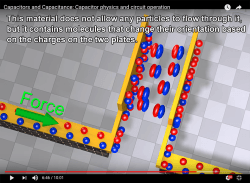Electrons and their invisible forces
February 21, 2018
on
on


of electronics shown as analogue
images by means of animations
Some of them receive, justifiably, hundreds of thousands or even millions of views. Thanks to the educational efforts of all sorts of people, any viewer, at his own level, can fill the gaps or illuminate the dark areas in his knowledge and progress at his/her own pace.
Animation: an unsurpassable educational tool
Recently I came upon some remarkable animations, using a different approach to any I have seen previously, which struck me for the qualities of originality, rigour, clarity, effectiveness. By this last word, I mean the ability of an explanation to tangibly show an abstract subject such as electromagnetic inductance. or to make transparent hidden processes such as what happens in the heart of an ordinary capacitor. The pinnacle of effective teaching is only achieved when a demonstration sticks in your memory, to reappear, sometimes years later, when you need that knowledge... or when it is asked of you to explain these phenomena to those with less knowledge than you.It's for this reason that I'm showing you two of these excellent animations (chosen from the most basic ones). If you don't know of these animations, you will no doubt be struck by the eloquence of their analogue representations.
Note: I will be very happy if the readers of this article list in the Comments below, any links to electronics videos that they think demonstrate clarity and educational effectiveness.
Read full article
Hide full article


Discussion (1 comment)